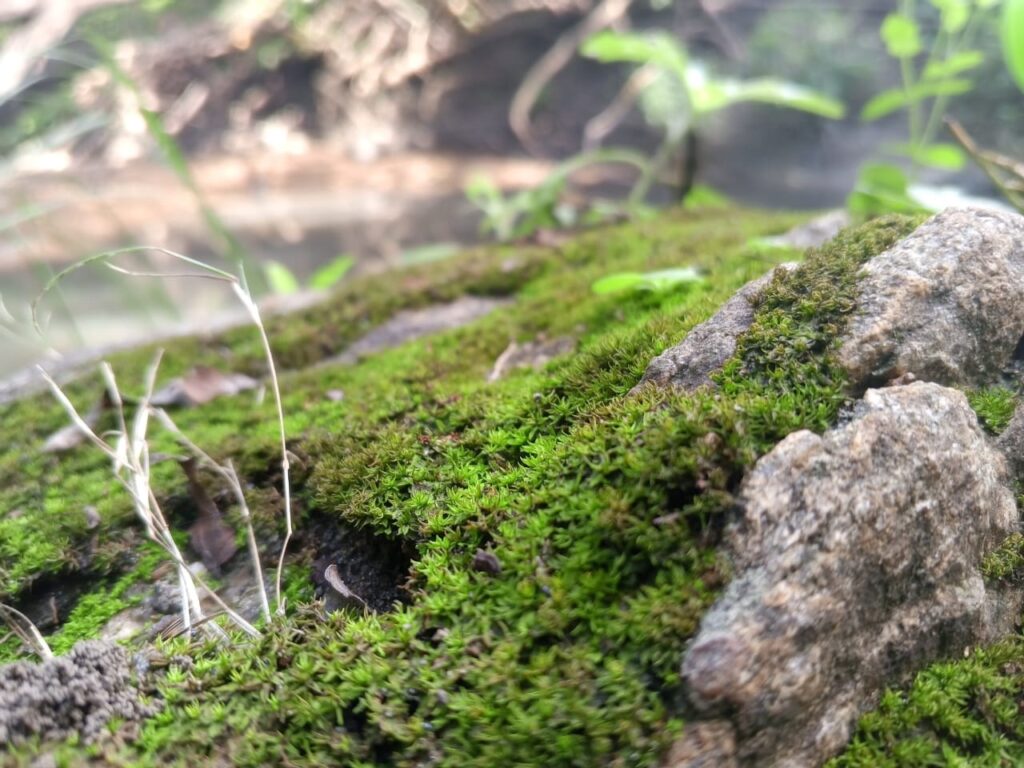Benin : Up Close with Bryophytes and Their Potential
Around the world, researchers are engaged in a discreet yet passionate hunt for bryophytes, these lesser-known lower plants with immense potential. Their mission: to uncover valuable molecules, understand their unique ecology, and unlock their resilience secrets. In the forests of Benin, we met some of them in search of answers about these long-overlooked species.

Bryophytes? These small, inconspicuous plants carpet the undergrowth, cling to mossy trunks, and colonize humid environments. Rural communities, particularly those living near forests, often encounter them but know little about their secrets. To shed light on these unknown plants, we embarked on an expedition deep into the dense and misty Lama Forest in Zogbomey. With backpacks on, hats pulled tight, and boots sinking into the soggy ground, we ventured alongside Gafarou Agoundé, a forest agronomist, and Ghyslain Chabi Kpétikou, a botanist. Both are PhD students at the University of Abomey-Calavi, meticulously scanning the environment for these enigmatic plants. “These lower plants form the second-largest division of the plant kingdom after angiosperms, with approximately 20,000 species,” explains Ghyslain Chabi.
Benin’s flora comprises 2,807 species. However, the inventory that led to this count a few decades ago did not include lower plants. The country still lacks a dedicated database for bryophytes. Gafarou Agoundé believes now is the time to closely monitor this climate-sensitive flora. “These species depend on humidity. As temperatures rise, environments become drier, affecting small plants like bryophytes. After identification, we will model species evolution on a spatial scale, simulating the impact of climate change over 30, 50 years, or even by the end of the century to determine which areas will remain suitable for certain bryophyte species,” explains Gafarou.
These two PhD students were selected as part of the BryoBen project, a research and training initiative aimed at equipping Benin with the necessary tools for bryophyte identification, taxonomy, data collection, and conservation assessment. The collected data (photos and species occurrence records) will be made available on platforms such as GBIF and iNaturalist. This journey begins with the collection of these tiny, green, flowerless species that attach themselves to trees or rocks. “We first need to go into the field, collect samples, and identify them. That’s what we have been doing for several weeks,” says Ghyslain Chabi Kpétikou, whom we met in late November 2024.
The Search for Bryophytes
The adventure began two months earlier for these bryophyte enthusiasts. They explored the Ouémé Supérieur classified forest in N'Dali, the Alibori-Supérieur classified forest, crossed river networks, examined the rock outcrops of Natitingou, and collected samples in the forests of the Kouffé Mountains in Agoua, Savalou, Dassa, Pobè, and Sakété. These expeditions allowed them to discover the three main classes of bryophytes: mosses, liverworts, and hornworts. “In Pobè, for example, we found great diversity. The same was true in Sakété,” notes Gafarou. Before them, two research teams had already ventured into Benin's forests to identify high-potential areas.
We met Dr. Jéronime Marie-Ange Ouachinou, a botanist specializing in ethnobotany, ethnopharmacology, and plant conservation, on the banks of the Banou River in the Mont Kouffé classified forest in Bantè. She is excited that Benin will soon learn more about these plants and their uses. “You can see these plants covering acacia branches, like along this river. It will be fascinating to see these studies through to the end. Global research efforts aim to identify molecules of interest for the cosmetic and pharmaceutical industries. Bryophytes also play a crucial role in soil development, the biogeochemical nutrient cycle, water retention, plant colonization, seed germination, seedling growth, and forest regeneration. They can serve as indicators for detecting changes in plant communities,” she explains.
Suspense!
However, we will have to wait a little longer for precise data on these lower plants in Benin. The collected samples are carefully stored at the National Herbarium of Benin at the University of Abomey-Calavi. Dr. Gbèwonmèdéa Hospice Dassou, director of the "Édouard Adjanohoun" Botanical and Zoological Garden at the University of Abomey-Calavi and coordinator of BryoBen, calls for patience. “Research on bryophytes in Benin is progressing slowly but surely. Since there are no bryologists in the sub-region, we benefit from the support of a group of bryology experts from the University of Cape Town in South Africa and the Kew Madagascar Conservation Centre, through the JRS Biodiversity Foundation,” he states.
In the coming weeks, Gafarou Agoundé and Ghyslain Chabi Kpétikou will receive training in South Africa to deepen their knowledge of bryophyte diversity. One of them will focus on the ethnobotanical uses of bryophytes by local communities and the impact of climate change on these plants. The other will specialize in taxonomy—all in an effort to explore and reveal the potential of Benin’s bryophytes.
